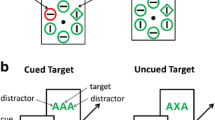Summary
Psychological opinion tends to sway between a view that people are almost infinitely flexible and a view that there are definite and unchangeable fundamental mechanisms that always work in the same way and set limits of flexibility. A popular compromise has been to suppose that ‘lower’ mechanisms are as determinate as typewriters, while ‘higher’ ones are unanalysable, autonomous, and perhaps even beyond scientific enquiry. The point of view in this paper favours a different compromise; very early and elementary operations are thought to be done in different ways, depending on the goals and experience of the person. There is, however, a good deal of constraint, which allows laws and principles to be laid down. Yet, there is also a degree of strategic flexibility in the operations actually performed that goes further than would be allowed by theorists of a different persuasion. The selective operations of attention are not due to unalterable mechanisms, nor does there seem to be convincing evidence of universal and invariant computation of all aspects of the input. What is computed, briefly, is the minimum necessary to perform the task before the person.
Similar content being viewed by others
References
Adams, R., & Berry, C. (1981). Memory for sentences: The subject superiority effect. Quarterly Journal of Experimental Psychology, 33A, 295–307.
Atkinson, R. C., & Shiffrin, R. M. (1968). Human memory: A proposed system and its control processes. In K. W. Spence (Ed.), The Psychology of Learning and Motivation (Vol. II, pp. 89–195). New York: Academic Press.
Baddeley, A. D. (1983). Working memory. Philosophical Transactions of the Royal Society of London, B 302, 311–324.
Baddeley, A. D. (1986). Working memory. Oxford: Oxford University Press.
Baddeley, A. D., & Hitch G. J. (1974). Working memory. In G. H. Bower (Ed.), The Psychology of Learning and Motivation (Vol. VIII, pp. 47–90). New York: Academic Press.
Baddeley, A., Lewis, V., Eldridge, M., & Thomson, N. (1984). Attention and retrieval from long-term memory. Journal of Experimental Psychology: General, 113, 518–540.
Broadbent, D. E. (1958). Perception and communication. New York: Pergamon.
Broadbent, D. E. (1971). Decision and stress. London: Academic Press.
Broadbent, D. E. (1981). From the percept to the cognitive structure. In A. D. Baddeley, & J. Long (Eds.). Attention & Performance (Vol. IX, pp. 1–24). Hillsdale, NJ: Lawrence Erlbaum.
Broadbent, D. E. (1982). Task combination and selective intake of information. Acta Psychologica, 50, 253–290.
Broadbent, D. E. (1984). The Maltese cross: A new simplistic model for memory. The Behavioral and Brain Sciences, 7, 55–94.
Broadbent, D. E., & Broadbent, M. H. P. (1981). Articulatory suppression and the grouping of successive stimuli. Psychological Research, 43, 57–67.
Craik, F. I. M. (1983). On the transfer of information from temporary to permanent memory. Philosophical Transactions of the Royal Society of London, B302, 341–359.
Duncan, J. (1980). The locus of interference in the perception of simultaneous stimuli. Psychological Review, 87, 272–300.
Eriksen, B. A., & Eriksen, C. W. (1974). Effects of noise letters upon identification of target in a non-search task. Perception & Psychophysics, 16, 143–149.
FitzGerald, J. P., Broadbent D. E. (1985). Order of report and the structure of short-term memory. Journal of Experimental Psychology: Learning, Memory, & Cognition, 11, 217–228.
Fodor, J. A. (1983). The modularity of mind. Cambridge, MA: MIT Press.
Gathercole, S., & Broadbent, D. E. (1984). Combining attributes in specified and categorized target search: Further evidence for strategic differences. Memory & Cognition, 12, 329–337.
Gregory, R. L., & Harris, J. P. (1975). Illusion-destruction by appropriate scaling. Perception, 4, 203–220.
Hoffman, J. E., Nelson, B., & Houck, M. R. (1983). The role of attentional resources in automatic detection. Cognitive Psychology, 51, 379–410.
Jones, G. V. (1983). Structure of the recall process. Philosophical Transactions of the Royal Society of London, B302, 373–385.
Kahneman, D., Treisman, A. (1984). Changing views of attention and automaticity. In R. Parasuraman, & D. R. Davies, (Eds.), Varieties of Attention (pp. 29–61). New York: Academic Press.
Kidd, A. L., & Cooper, M. B. (1985). Man-machine interface issues in the construction and use of an expert system. International Journal of Man-Machine Studies, 22, 91–102.
Marr, D. (1982). Vision. San Francisco: W. H. Freeman.
McLean, J. P., Broadbent, D. E., & Broadbent, M. H. P. (1982). Combining attributes in rapid sequential visual presentation. Quarterly Journal of Experimental Psychology, 35A, 171–186.
McLeod, C. (1984). Pronoun identification: The coordination of available information. Thesis approved for Ph. O. degree, University of Oxford.
Morton, J. (1981). The status of information processing models of language. Philosophical Transactions of the Royal Society of London, B295, 387–396.
Routh, D. (1976). An ‘across-the-board’ modality effect in immediate serial recall. Quarterly Journal of Experimental Psychology, 28, 285–304.
Schneider, W., & Fisk, A. D. (1984). Automatic category search and its transfer. Journal of Experimental Psychology: Learning, Memory, & Cognition, 10, 1–15.
Schneider, W., & Shiffrin, R. M. (1977). Controlled and automatic human information processing: I. Detection, search, and attention. Psychological Review, 84, 1–66.
Shiffrin, R. M. (in press). Attention. In R. C. Atkinson, R. J. Herrnstein, G. Lindzey, & R. D. Luce, (Eds.), Stevens' Handbook of Experimental Psychology, 2nd edition. New York: Wiley.
Shiffrin, R. M., Dumais, S. T., & Schneider, W. (1981). Characteristics of automatism. In J. Long & A. D. Baddeley, (Eds.), Attention & Performance (Vol. IX, pp. 223–238). Hillsdale, NJ: Lawrence Erlbaum.
Simon, H. A. (1983). Reason in human affairs. Stanford: Stanford University Press.
Sperling, G. (1960). The information available in brief visual presentations. Psychological Monographs, 74 (Whole Number 498), 1–29.
Tannenbaum, P., & Williams, F. (1968). Prompted word replacement in active and passive sentences. Language and Speech, 11, 220–229.
Wilhite, S. C. (1982). Sentence coding: Tests of the address-contents model and the fragmentation-conceptual hypothesis. Quarterly Journal of Experimental Psychology, 34A, 259–274.
Wright, P. (1969). Transformation and the understanding of sentences. Language and Speech, 12, 156–160.
Author information
Authors and Affiliations
Rights and permissions
About this article
Cite this article
Broadbent, D. Structures and strategies: Where are we now?. Psychol. Res 49, 73–79 (1987). https://doi.org/10.1007/BF00308671
Received:
Issue Date:
DOI: https://doi.org/10.1007/BF00308671




